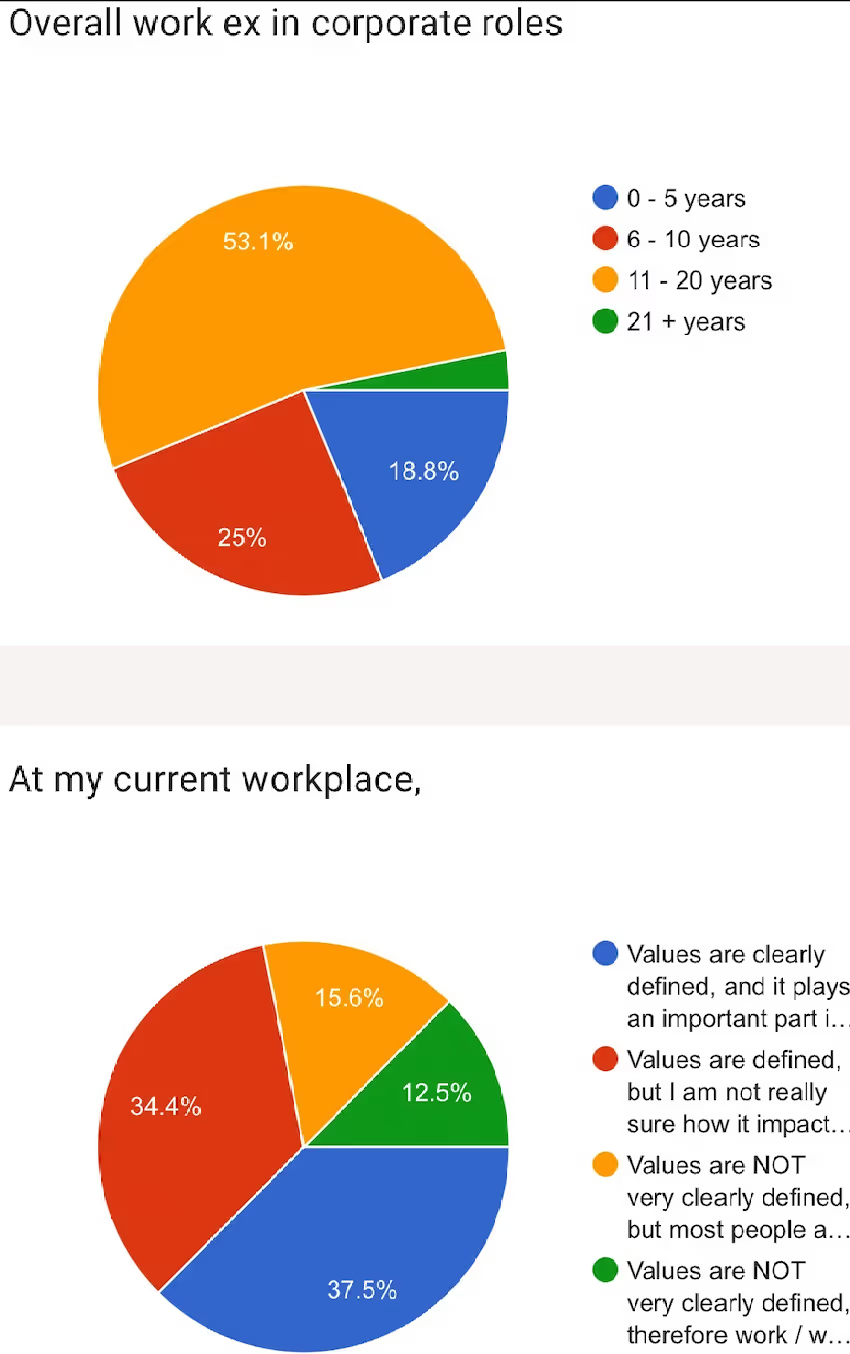
From website slogans to interview mantras, values are everywhere. They are woven into the fabric of onboarding programs as new recruits take their first steps into the organisation. They are repeated ad nauseam in meetings and in townhalls. They permeate our work lives, making their way into recruitment, assessments, performance evaluations and recognition programs.
Have you found yourself drowning in a sea of words splashed across the “who we are” section of the company website? Have you seen or heard of these words and phrases more times than you have had coffee today?!
Painting company values on the walls certainly makes for great social media posts, but what are the tangible implications of values in our everyday work?
What is the big deal with values, anyway?
The concept of values took the corporate world by storm in 1994 after the release of the book “Built to last” by James Collins and Jerry Porras. The key concept was that visionary organisations build businesses driven by purpose, rather than just profits. Purpose along with “Core values” allows organisations to set themselves apart from competition by clarifying their identity and what they stand for.
However, organisation values are often given the side-eye because business history is replete with examples of large organisations that espoused “honesty” and “integrity” as their core values, but were involved in scams and financial frauds of unimaginable scales.
A social experiment
I ran a survey on my social media accounts (LinkedIn) to understand people’s perceptions. And here are the results:

37.5% of all respondents agreed that values are clearly defined in their respective organisations, and it plays an important part in their everyday work lives.
Digging deeper, 50% of the 0-5 years work experience cohort responded that they were unsure of how values impacted their daily work, even though their organisations had well defined values. One would think this is expected, given that this group may have not yet experienced deep challenges or conflicts at the workplace, where values come in handy.
There are some expectations for this norm. Ashwin*, a fresh MBA graduate joined a leading consulting firm as a strategy consultant less than a year ago. He says values were THE most important part of his induction and play a key role in his everyday work. “I deal with clients from different industries, geographies and cultures. It sometimes becomes tricky to manage their requests and expectations. That is when I fall back on the organisation’s values, it becomes very easy to explain why I have to decline a particular request, or why I chose one approach over another.”
The Values Conundrum
Rheeba* works at a tech firm providing digital transformation services that holds “Innovation” as a core value. She is concerned about the lack of clarity around how to truly live the value. “Innovation requires a culture of acceptance of failures. It requires employees to feel secure and fearless about trying new approaches. I don’t really know how my performance will be assessed if I “fail” while trying to innovate. Will I be rewarded or appreciated for trying to innovate, or will I be held responsible for failing to produce an impactful outcome?” she wonders.
This conundrum is not uncommon. As I recount several experiences and discussions, I can broadly categorise such conflicts into three buckets:
1. When values are not actionable – Values like “Excellence”, “Creativity” or “Innovation” remain mere words at 30,000 feet as employees struggle to operationalise it. The danger with such values is that the means to these values could differ vastly from person to person. Rather than stating the “What”, it becomes important to break down the “How” of the value.
Several organisations choose to function without declaring values rather than having values which are un-lived. In organisations where values were NOT clearly defined,
•It was interesting to note that 16% respondents on the survey believed that even though values were not defined at their workplaces, most people at work know what the core values and beliefs of their workplaces are.
•14% respondents said that work and work culture is hard to navigate due to an absence of values.
As organisations scale in head count, or across geographies, it becomes important to have a unifying message (whether values or otherwise) that acts as a north star for everyone within the organisation.
An organisation that I consult with believes that values are larger than life, which makes it unrealistic and too distant from the reality of everyday work. We have therefore chosen to create a set of “operating principles” that lists behaviours that every person in the organisation can relate to.
2. When there are seemingly conflicting values declared by the organisation - Dive Deep (stay immersed in details and scrutinise them) seems to be at loggerheads with Bias for Action (Speed in decision making without extensive time spent on details). How do employees react in such situations of dilemma? Some organisations adopt a prescriptive “value ladder” approach, where values are ranked in order of importance. Most organisations rely on their leadership layers to provide the insight and guidance needed to make decisions in moments of conflict.
Either way, acknowledging challenges that employees may face in upholding organisation values, and providing a safe space to discuss and debate these concerns must be top priority.
3. Processes / culture that does not support values – Consider the classic “Quality vs Speed” dilemma. When an organisation declares quality as a core value, but the performance system is over indexed on evaluating employees on speed of delivery, it naturally encourages teams to focus on speed rather than quality. It becomes important to ensure that all processes are in alignment with values.
It is natural for such conflicts to exist in an organisation ecosystem, however care must be taken to ensure that there are adequate processes laid out to support core values. In this case, will instituting a formal quality review process help build greater sensitivity to quality? Will investing in benchmarking and knowledge sharing on industry best practices improve quality focus within the team?
Values - not a magic potion!
“Aspirational values” are those that the organisation needs to succeed in the future, but currently lacks. This is typically done to support a new strategy or direction that an organisation may want to pursue. A tech service provider I was consulting with wanted to introduce a value of “radical honesty” in order to encourage open conversation and feedback within the organisation. After several rounds of leadership discussions, they were convinced that this value would be their way of work in future. However, from their employee satisfaction survey, it was clear that the existing culture did not encourage open feedback, especially upward feedback. We put the value idea on hold and instead ran a series of anonymous surveys to lay the foundation for a culture that thrived on feedback. In hindsight, we dodged chaos that would have ensued had we launched the value. Sometimes, instituting values does not solve the problem, it only worsens it!
Hari Gomatam is a values expert, who has anchored value exercises across several organisations. He shares insights on how sticking to values requires tenacity. “Transparency is a value at an educational institution I work with. We continuously invite feedback on values and listen for areas of dissonance. Through this process, we understood that staff expected greater clarity around the P&L of the institution. We now have a process of displaying these details in staff rooms. Do these processes make the management more liable to answer questions? – Yes. Does it give employees a sense of security and belief that the organisation is truly living its values? – that is a resounding Yes. The value of transparency has translated to far greater engagement for the institution as a whole!”
How accessible are values?
Given my prior work in equity and inclusion, I have learnt to look at all organisation systems with a lens of accessibility. How accessible are values to different sections of the organisation? Do employees on the shop floor understand values? Are efforts being made to cascade it in regional languages? Is there sensitivity around cultural nuances when values are communicated? Do all employees relate to the realities around values? Are values applicable to those outside of the organisation ecosystem?
Kalai is a senior retail sales officer at a leading branded jewellery partner store. While she is not directly an employee of the organisation, she is very cognisant of her role as a representative of the brand “Customer experience is my top priority. People buy our jewellery based on the trust our brand name commands. I ensure that my actions uphold this trust.” Her words may not match every word of the value statement of the parent company, but her succinct understanding of her responsibilities in upholding the ethos of the company shines bright.
Hari weighs in on this, “At an engineering organisation my role was to ensure that the same value was lived across employees irrespective of their role or the geography they belonged to. The same value applied to a CFO as it did to a logistics manager, or a forklift operator. We made it actionable by instituting rituals that were unique to the specific role. Sharing stories of employees and teams' living values helped in building a shared understanding of values. What really moved the needle for us was to have “Value conversations”. A large part of performance discussions was focussed not just on what was achieved, but also on HOW it was achieved.”
Navigating values needs the right intent and commitment. When practiced in letter and spirit, values open the employer to constant scrutiny and vulnerability. The benefits of going through this arduous process, however, yields very rewarding outcomes!
In summary, here is a checklist for employers to consider:
- Values must be authentic
- Actionable values ensure greater clarity and resonance
- Be cognisant of accessibility of values across employee & stakeholder groups
- Create safe spaces for employees to voice their concerns / dissonance with values
- Run all processes against the value filter to discover and fix contradictions
- Values may not be the solution to all problems!
* Names changed to protect privacy


.svg)










.png)



.png)



.svg)
